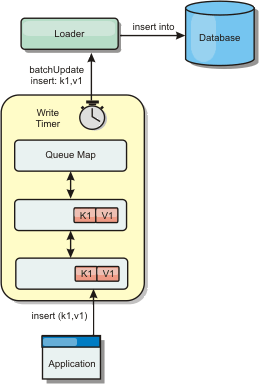Write-behind caching
You can use write-behind caching to reduce the overhead that occurs when updating a database you are using as a back end.
Write-behind caching overview
Write-behind caching asynchronously queues updates to the Loader plug-in. You can improve performance by disconnecting updates, inserts, and removes for a map, the overhead of updating the back-end database. The asynchronous update is performed after a time-based delay (for example, five minutes) or an entry-based delay (1000 entries).

The write-behind configuration on a BackingMap creates a thread between the loader and the map. The loader then delegates data requests through the thread according to the configuration settings in the BackingMap.setWriteBehind method. When an eXtreme Scale transaction inserts, updates, or removes an entry from a map, a LogElement object is created for each of these records. These elements are sent to the write-behind loader and queued in a special ObjectMap called a queue map. Each backing map with the write-behind setting enabled has its own queue maps. A write-behind thread periodically removes the queued data from the queue maps and pushes them to the real back-end loader.
The write-behind loader only sends insert, update, and delete types of LogElement objects to the real loader. All other types of LogElement objects, for example, EVICT type, are ignored.
Write-behind support is an extension of the Loader plug-in, which you use to integrate eXtreme Scale with the database. For example, consult the Configuring JPA loaders information about configuring a JPA loader.
Benefits
Enabling write-behind support has the following benefits:- Back end failure isolation: Write-behind caching provides an isolation layer from back end failures. When the back-end database fails, updates are queued in the queue map. The applications can continue driving transactions to eXtreme Scale. When the back end recovers, the data in the queue map is pushed to the back-end.
- Reduced back end load: The write-behind loader merges the updates on a key basis so only one merged update per key exists in the queue map. This merge decreases the number of updates to the back-end database.
- Improved transaction performance: Individual eXtreme Scale transaction times are reduced because the transaction does not need to wait for the data to be synchronized with the back-end.